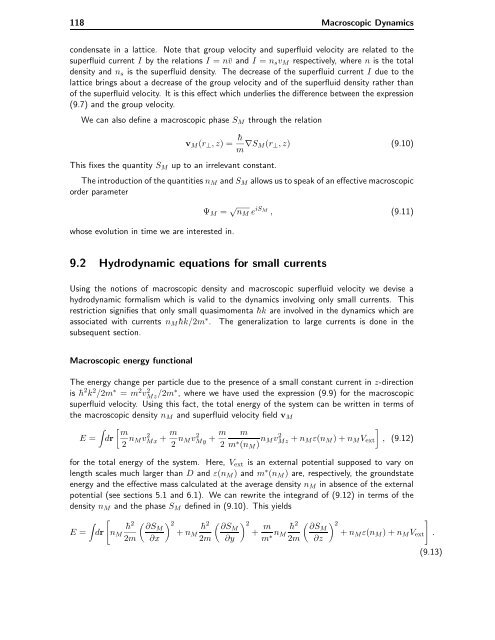Bose-Einstein Condensates in Rotating Traps and Optical ... - BEC
Bose-Einstein Condensates in Rotating Traps and Optical ... - BEC
Bose-Einstein Condensates in Rotating Traps and Optical ... - BEC
You also want an ePaper? Increase the reach of your titles
YUMPU automatically turns print PDFs into web optimized ePapers that Google loves.
118 Macroscopic Dynamics<br />
condensate <strong>in</strong> a lattice. Note that group velocity <strong>and</strong> superfluid velocity are related to the<br />
superfluid current I by the relations I = n¯v <strong>and</strong> I = nsvM respectively, where n is the total<br />
density <strong>and</strong> ns is the superfluid density. The decrease of the superfluid current I due to the<br />
lattice br<strong>in</strong>gs about a decrease of the group velocity <strong>and</strong> of the superfluid density rather than<br />
of the superfluid velocity. It is this effect which underlies the difference between the expression<br />
(9.7) <strong>and</strong> the group velocity.<br />
We can also def<strong>in</strong>e a macroscopic phase SM through the relation<br />
vM(r⊥,z)= ¯h<br />
m ∇SM(r⊥,z) (9.10)<br />
This fixes the quantity SM up to an irrelevant constant.<br />
The <strong>in</strong>troduction of the quantities nM <strong>and</strong> SM allows us to speak of an effective macroscopic<br />
order parameter<br />
whose evolution <strong>in</strong> time we are <strong>in</strong>terested <strong>in</strong>.<br />
ΨM = √ nM e iSM , (9.11)<br />
9.2 Hydrodynamic equations for small currents<br />
Us<strong>in</strong>g the notions of macroscopic density <strong>and</strong> macroscopic superfluid velocity we devise a<br />
hydrodynamic formalism which is valid to the dynamics <strong>in</strong>volv<strong>in</strong>g only small currents. This<br />
restriction signifies that only small quasimomenta ¯hk are <strong>in</strong>volved <strong>in</strong> the dynamics which are<br />
associated with currents nM¯hk/2m ∗ . The generalization to large currents is done <strong>in</strong> the<br />
subsequent section.<br />
Macroscopic energy functional<br />
The energy change per particle due to the presence of a small constant current <strong>in</strong> z-direction<br />
is ¯h 2 k2 /2m∗ = m2v2 Mz /2m∗ , where we have used the expression (9.9) for the macroscopic<br />
superfluid velocity. Us<strong>in</strong>g this fact, the total energy of the system can be written <strong>in</strong> terms of<br />
the macroscopic density nM <strong>and</strong> superfluid velocity field vM<br />
<br />
E =<br />
<br />
m<br />
dr<br />
2 nMv 2 Mx + m<br />
2 nMv 2 My + m<br />
2<br />
m<br />
m∗ (nM) nMv 2 <br />
Mz + nMε(nM)+nMVext , (9.12)<br />
for the total energy of the system. Here, Vext is an external potential supposed to vary on<br />
length scales much larger than D <strong>and</strong> ε(nM) <strong>and</strong> m ∗ (nM) are, respectively, the groundstate<br />
energy <strong>and</strong> the effective mass calculated at the average density nM <strong>in</strong> absence of the external<br />
potential (see sections 5.1 <strong>and</strong> 6.1). We can rewrite the <strong>in</strong>tegr<strong>and</strong> of (9.12) <strong>in</strong> terms of the<br />
density nM <strong>and</strong> the phase SM def<strong>in</strong>ed <strong>in</strong> (9.10). This yields<br />
<br />
E = dr<br />
nM<br />
¯h 2 2 ∂SM<br />
+ nM<br />
2m ∂x<br />
¯h 2 2 ∂SM<br />
2m ∂y<br />
+ m<br />
nM<br />
m∗ ¯h 2 <br />
2<br />
∂SM<br />
+ nMε(nM)+nMVext .<br />
2m ∂z<br />
(9.13)




